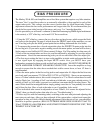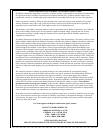
The Manley 250 & 500 watt Amplifiers use a fixed bias system that requires very little attention.
The term "bias" as used here refers to an externally adjustable voltage applied to each of the
output tubes grids. This voltage sets the correct current draw for each output tube. Proper
adjustment ensures the best sonic performance and longest tube life. We recommend that you
check the bias upon initial receipt of the amps, and every 2 or 3 months thereafter.
For this procedure you will need a voltmeter (a hand held autoranging DMM digital multimeter
is the easiest), a 3/32" allen key, and a small 1/8" flat screwdriver.
1. Using the 3/32" allen key, remove the two silver hex cap head screws which secure the black
oval insert to the faceplate. On page 8, which shows the FRONT panel of the amplifier, you can
see 10 red tip jacks plus the black ground point that are hiding underneath the oval insert.
2. To measure the current draw of each output tube place the POSITIVE meter probe into the
first red tip jack. (If you read a negative reading reverse the meter probes, no harm will be done.)
Set the meter to read 'millivolts' DC (direct current) Voltage. You'll be reading less than one volt.
3. Each of the ten output tubes can have its own bias adjusted by adjusting its own bias adjust
potentiometer. Above the measurement tip jacks you can see each tube's blue bias adjust pot.
4. The first step to setting the bias is to turn on the amplifier in triode mode and ensure that there
is zero signal input by engaging the Input MUTE switch. Also, you MUST leave your
loudspeakers connected as these provide an ideal load on the output. DO NOT EVER OPERATE
YOUR AMPLIFIER WITHOUT SPEAKERS CONNECTED! Leave the amplifier on long
enough to ensure that the tubes have reached their stable current draw, at least 1/2 hour is
recommended.
5. Place the meter probes in the first red tip jack to read output tube #1. Adjust the first bias trim
pot slowly until you measure 275-285 mVDC (0.275V to 0.285VDC). Since you are measuring
across a 10 ohm cathode resistor, this would correspond to a 27 to 28 mA current draw for each
tube by Ohm's law. A reading of 0mV can indicate a failed tube, or an open cathode resistor. A
reading of 0mV on ALL tubes (powered on condition) can mean the B+ fuse has blown. The
cause of this should be investigated before simply putting a new fuse in. You probably lost a tube
and it blew the fuse. Have a look at the tubes to see if something looks weird.
6. If an individual tube cannot be adjusted to at least 250mV, or it cannot be adjusted below
300mV, then you should replace that tube (also see "Troubleshooting").
7. Follow step five with the remaining tubes, switching to the next tube point and adjusting the
next trim pot each time. After you have adjusted all the output tubes, recheck and repeat the
procedure as they will drift a little bit during adjustment. Once they are all set, your amplifier
should be in perfect operation. (BIAS IN TETRODE MODE SHOULD READ 270mV TO
310mV. THERE IS A MASTER BIAS ADJUSTMENT TRIMPOT INSIDE THE UNIT, THIS
TRIMPOT IS FACTORY SET ).
9
BIAS PROCEDURE


















